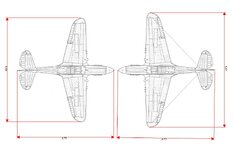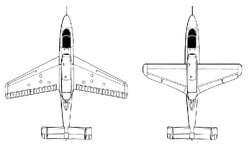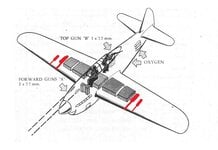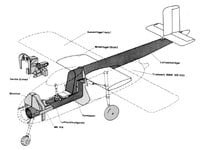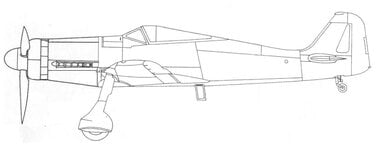Shortround6
Lieutenant General
According to some accounts the Fury Monoplane came up in discussions in Aug 1933 between Camm and Major Buchanan of the Directorate of Technical Development, Air Ministry.
Engine was to be the Goshawk (not yet falling from favor), fixed spatted undercarriage, and four guns. Early the following year they altered things to take the P.V. 12 engine. Introduced an enclosed canopy and started on the retractable landing gear.
After partial conformity to interim Specification F 5/34 an new Specification F.36/34 was drafted around the the Design as it stood in August 1934 and the new monoplane fighter was tendered to that Specification on Sept 1934. The design was accepted and in Feb 1935 a contract was raised for the construction of one prototype to have four guns, one (Vickers) in each side of the fuselage and one (Vickers or Browning) in each wing. Arguments for heavier armament were accepted and the contract was amended to provide for eight Brownings to be mounted in the wing.
Prototype was first flown Nov 6th 1935.
To put this into perspective. The conteders for the F.7/30 fighter specification (issued Feb 1931) flew in the following order.
Supermarine Type 224 Feb 19 1934 (M)
Westland P.V. 4 March 23 1934
Bristol type 123 June 12th 1934
Hawker P.V. 3 June 15th 1934
Blackburn F.3 Taxi trials July 30 1934 never flown
Bristol type 133 June 8 1934 (M)
M is for monoplane
and the "winner" although not actually entered in the competition, was the Gladiator, first flown on Sept 19th 1934 after the abject failure of the Goshawk engine took all of the contenders except the Bristol 133 (Mercury engine) out of contention.
Bristol 133

It did not get the sliding canopy until 2 months after the first flight and was crashed in March 1935 while completing manufacture's handling and performance trials just before being handed over for service evaluation. Pilot forgot to retract the landing gear and tried to do a spin the with the landing gear extended. Designer was already working on a new design but that didn't fly until Feb 1938.
Ability of Camm and Hawker to sandwich in a Fury Monoplane into that time line?
also note that the higher power Kestrels don't show up until 1936 or later. At least the ones that make power at 14,500ft. There were some earlier 730hp versions but that required low supercharger gears and FTH was 5250ft.
Engine was to be the Goshawk (not yet falling from favor), fixed spatted undercarriage, and four guns. Early the following year they altered things to take the P.V. 12 engine. Introduced an enclosed canopy and started on the retractable landing gear.
After partial conformity to interim Specification F 5/34 an new Specification F.36/34 was drafted around the the Design as it stood in August 1934 and the new monoplane fighter was tendered to that Specification on Sept 1934. The design was accepted and in Feb 1935 a contract was raised for the construction of one prototype to have four guns, one (Vickers) in each side of the fuselage and one (Vickers or Browning) in each wing. Arguments for heavier armament were accepted and the contract was amended to provide for eight Brownings to be mounted in the wing.
Prototype was first flown Nov 6th 1935.
To put this into perspective. The conteders for the F.7/30 fighter specification (issued Feb 1931) flew in the following order.
Supermarine Type 224 Feb 19 1934 (M)
Westland P.V. 4 March 23 1934
Bristol type 123 June 12th 1934
Hawker P.V. 3 June 15th 1934
Blackburn F.3 Taxi trials July 30 1934 never flown
Bristol type 133 June 8 1934 (M)
M is for monoplane
and the "winner" although not actually entered in the competition, was the Gladiator, first flown on Sept 19th 1934 after the abject failure of the Goshawk engine took all of the contenders except the Bristol 133 (Mercury engine) out of contention.
Bristol 133
It did not get the sliding canopy until 2 months after the first flight and was crashed in March 1935 while completing manufacture's handling and performance trials just before being handed over for service evaluation. Pilot forgot to retract the landing gear and tried to do a spin the with the landing gear extended. Designer was already working on a new design but that didn't fly until Feb 1938.
Ability of Camm and Hawker to sandwich in a Fury Monoplane into that time line?
also note that the higher power Kestrels don't show up until 1936 or later. At least the ones that make power at 14,500ft. There were some earlier 730hp versions but that required low supercharger gears and FTH was 5250ft.

